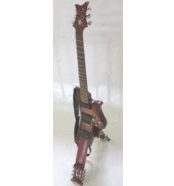Extra Strings for New Sounds
A new musical instrument strums like a guitar but rings like a bell.
By Emily Sohn
You’ve heard of pianos, violins, and guitars. Now, make room for the tritare (rhymes with guitar). Canadian mathematicians have invented the new music-making device by tweaking the standard concept of a stringed instrument.
 |
|
The tritare, a new type of musical instrument, uses a Y-shaped string anchored at three endpoints. |
| Samuel Gaudet, University of Moncton |
Instead of having strings that stretch between two points, the tritare has strings that are attached to the instrument at more than two points. Picture, for example, a Y-shaped string, anchored at its three endpoints.
When played, the instrument produces an eerie sound that challenges the ears with complicated echoes and vibrations.
The tritare looks like a guitar with two extra necks. One of the necks has thin crossbars, or frets, that mark places where pushing on strings creates desired pitches. The other two necks are unfretted.
 |
|
The tritare uses three string segments that form a Y shape (left). The instrument’s inventors are exploring sounds generated by other string networks as well (right). |
| Samuel Gaudet, University of Moncton |
Plucking, strumming, or bowing a normal guitar string creates mathematically related sounds called harmonic overtones. For the most part, a string vibrates at a specific, standard rate (or frequency), say 440 times per second, which is the note A. But it also vibrates at twice that rate, creating a sound called the second harmonic. The string’s vibration at three times the basic rate is called the third harmonic, and so on.
Playing the tritare generates harmonic overtones, but it also creates sounds that are nonharmonic. Nonharmonic frequencies fit in between the harmonic frequencies.
Harmonics sound simple, familiar, and pleasant to our ears. Nonharmonics, which are often produced by gongs, bells, and other percussion instruments, sound more complicated. If played correctly, the tritare can produce many nonharmonics at once.
The researchers, who are at the University of Moncton in New Brunswick, say that the tritare’s sound is beautiful and has lots of potential for musical expression.
“Sounds which are richer and less safe harmonically . . . provide inspiration and ways to musically express different things,” says Samuel Gaudet, one of the inventors.
Other researchers are more skeptical.
“To my ears [the tritare] just sounded like a badly out-of-tune instrument,” says acoustics specialist Bernard Richardson of Cardiff University in Wales.
Someday, more complicated string instruments might challenge your sense of music even more. Will you be a fan? Check the following Web page, where you’ll find some samples of such sounds to help you decide: www.acoustics.org/press/151st/Leger.html.—E. Sohn
Going Deeper:
Weiss, Peter. 2006. String trio: Novel instrument strums like guitar, rings like bell. Science News 169(June 3):342. Available at http://www.sciencenews.org/articles/20060603/fob7.asp .
For additional information about the tritare, go to www.acoustics.org/press/151st/Leger.html (Acoustical Society of America).
Science project idea: Instead of Y-shaped strings, try other patterns. How does the string geometry affect the sounds created by a musical instrument?







